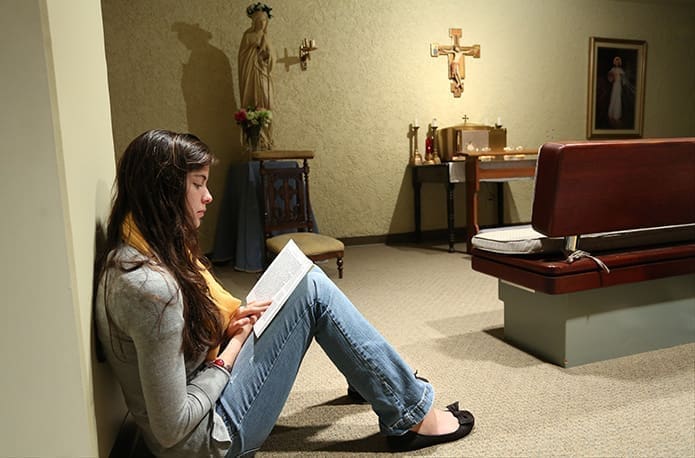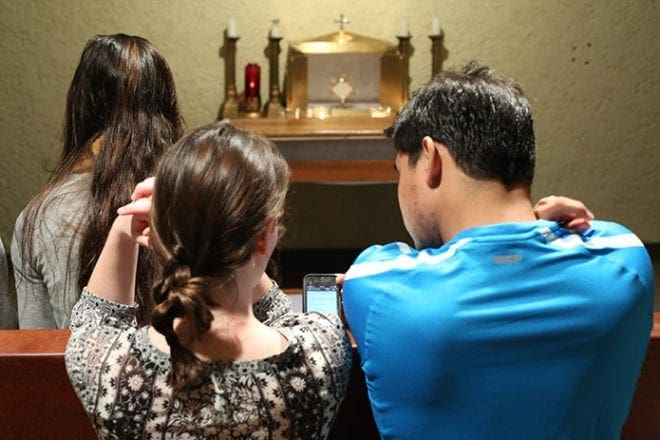 Photo By Michael Alexander
Photo By Michael AlexanderAtlanta
Hour of adoration leavens stressful grind for Georgia Tech students
By ANDREW NELSON, Staff Writer | Published January 23, 2014
ATLANTA—Sunrise is still an hour away. The Georgia Tech campus is in its pre-dawn quiet. In a dimly lit chapel, students pray.
The open doors of the tabernacle show the Eucharist exposed in a small monstrance. Small flames from four candles shine in the room. A girl sits on the floor. Another reads from her tablet computer.
Clare Botti wakes up at 5:30 a.m. for her assigned hour of prayer at 6:15 a.m. It’s a five-minute walk from her Perry Hall dorm.
“I made the time early because my classes start early. I prefer to begin my day with a holy hour,” said the first-year biomedical engineering student. Dark-haired, Botti, 18, has on jeans and is draped in a stylish wrap. She grew up in Woodstock and attended St. Michael the Archangel Church.
“I begin my day thinking about why I am here. It gives me more purpose,” she said, before leaving for her 8 a.m. English class.
These digital natives at Georgia Tech set aside their texting, Twitter and their textbooks. Instead they sit and kneel in this quiet room. The traditional prayer spent in front of the Eucharist is getting underway as a much more frequent offering at the Catholic Center as the semester begins.
The Catholic ritual of adoration fell out of usage in the 1970s and 1980s, but, anecdotally, seems to be drawing in more people, especially among young adults experiencing it for the first time.
Dan Fitzgerald, 22, a computer science major, sits in the chapel’s front row. He wears a black and white cassock and surplice, the church-prescribed attire to lead adoration.
He gets here a little after 6 a.m. to light the candles and prepare the chapel. The fourth-year student is one of the leaders who got the program going. It started last fall at the worst possible time as students entered exam week, he said, but still they signed up to give an hour of their time each week here in prayer.
“I know there are little, small, quiet transformations happening,” said Fitzgerald, whose family attends St. Ann Church, in Marietta.
The students pray for themselves and for others, Monday to Friday, from 6 a.m. to midnight, a total of 90 hours of adoration. A red book of prayer on the table outside the chapel is filled with longings written anonymously.
“For safety on campus.”
“(For) those who feel they have no path.”
“For my future. I always feel lost and scared.”
“That I may keep hope for my final semester.”
Erin Grace Fitzpatrick finds a welcome lull in her day here.
“At GT, you are always so busy. When you go into the chapel, you are able to be very prayerful, have a conversation with God on a deeper level,” she said.

Casie Connolly, left, a freshman environmental engineering major at Georgia Tech, and Fernando Medina, a 2013 master’s degree recipient, use a smart phone app to follow along during pre-morning prayer. Photo By Michael Alexander
“That quietness helps you unwind, de-stress, and get everything together before you go back out into the busy world of Tech,” said the 19-year-old first-year student from Brookhaven. She attended Marist School where for years she worshipped at the 7:30 a.m. campus Mass.
Christopher Sharpe first saw adoration when he visited the Cathedral of Christ the King and its chapel.
“They were quiet and reverent in front of a monstrance. I knew something important was going on, but I didn’t know what it was,” said Sharpe, 33, a business administration major, who joined the church in 2013.
For a former Southern Baptist, the Catholic prayer style is very different.
“You treat prayer like a conversation with Christ,” he said.
“I had never thought to go and have a conversation. The sacrament allows you to do that,” said Sharpe, who has on rimless glasses and a sweater over a button-down Oxford shirt.
He said he spends his time saying prayers of thanks, contemplating his day with an Ignatian style of reflection, and reading a spiritual book, like the one he’s now reading, called “Soul of the Apostolate.”
Eucharistic adoration is a church tradition but can seem new to young Catholics since the church re-emphasized community worship after Vatican II. The prayer has been a centerpiece of World Youth Day celebrations, allowing young adults to join in praying this way with recent popes, including Pope Francis in Rio de Janeiro, Brazil.
Georgia Tech campus minister Father Kevin Peek said the new activity “gives everyone a sense of comfort” knowing that people are praying. Everyone—a student or any person in the area—is welcome to stop in whether for five minutes or longer, he said.
Adoration is more available than when he attended college, he said, but now the “presence of Christ in the Eucharist has become more of a focal point, perhaps because more and more people are needing to know the love of God.”
For young Catholics, the old can seem new.
Jesuit Father Brian Daley contributed a chapter to “Awake My Soul: Contemporary Catholics on Traditional Devotions” on adoration of the Eucharist.
The Notre Dame theology professor said in an email that college students could be “attracted by the possibility of trying out an older way of praying, which seems paradoxically new!”
Also, he said, young people may have heard about this style from parents and grandparents.
“I know a lot of young people who would like at least to try these more traditional practices for themselves,” he said.
A 2008 study by the Center for Applied Research in the Apostolate at Georgetown University found 21 percent of Catholic “millennials,” those born after 1981, have participated in Eucharistic adoration.
Professor Willian Dingas, area director of religion and culture in the School of Theology and Religious Studies at Catholic University of America, has seen more people drawn to it, too. Adoration can be a way to maintain a distinctive Catholic identity, he said. “It’s a way to say the sacred is still alive” and “sacred pushback” in an environment some view as unfriendly to faith, he said. The question for him is whether Catholics use this individual prayer as a springboard to work on issues of justice on campus and in their communities, he said.
Jackie Sample, 22, called herself a once “superficial Catholic,” hitting the Tech campus parties and the college Greek life.
“Now, I know I can’t live without prayer,” said Sample, a marathon runner and a business and international affairs major. Her family worships at Holy Trinity Church in Peachtree City.
Sample is here in the campus adoration chapel at 3:15 p.m. every Wednesday. It’s the part of her day when she’s most at peace, she said. “I can’t put it into words. I can’t explain it.”